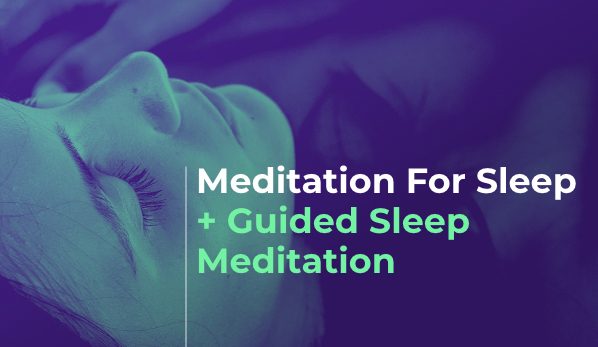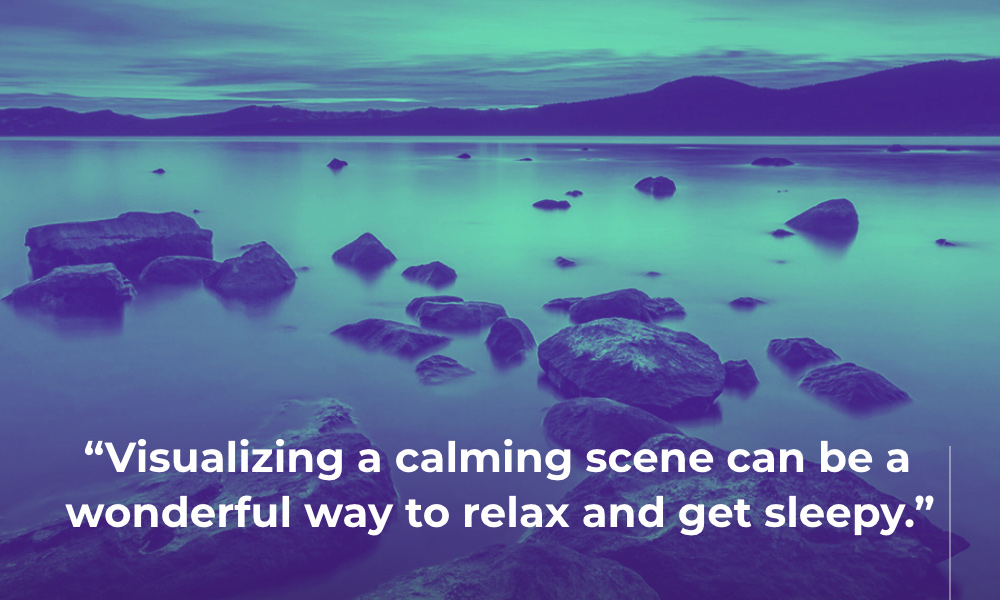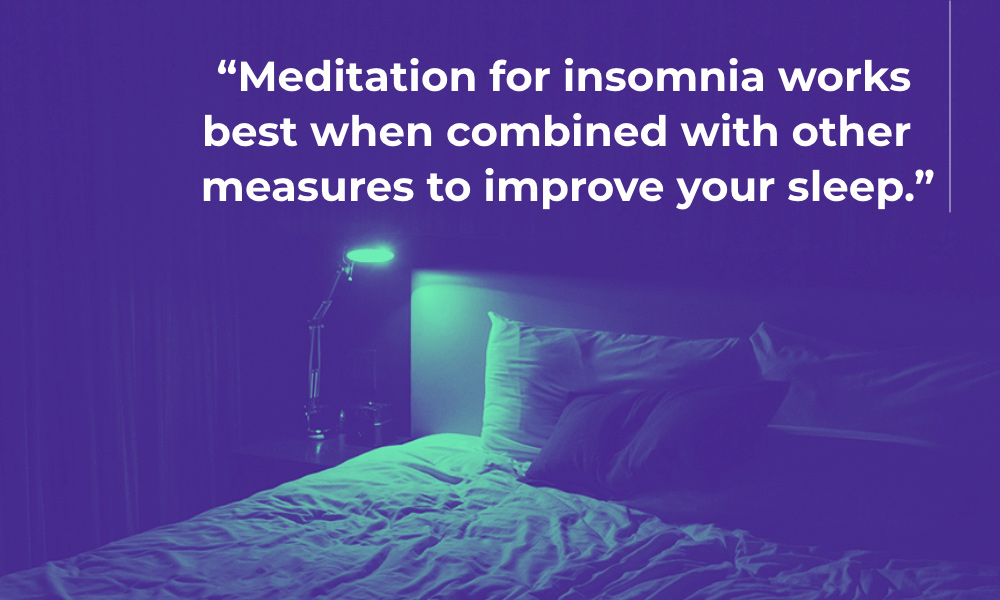Sleep disturbances can be inconvenient, causing a bad mood and an unproductive workday. Even worse, a lack of sleep can have grave implications for your health, like a compromised immune system, weight gain, and high blood pressure. The good news is that you can do something about it. If you find it hard to get a good night’s sleep or would just like to get better sleep, we’d like to introduce you to meditation for sleep.
A Guided Meditation to Help You Sleep and Relax
Does Meditation Help with Sleep?
Yes, meditation helps with sleep. Meditation can help with sleep in two ways. One way is to use a sleeping meditation right before you go to bed at night, to help you relax and drift into sleep. Another way is to use meditation during the day to help you regulate the hormones that control your sleeping patterns–meaning even if you fall asleep first thing in the morning, it can still help you fall asleep at night.
Meditation’s Effect on Sleep
Let’s take a look at a few of the ways meditation helps you fall asleep faster and stay asleep throughout the night:
Regulates Sleep Hormones
In a perfect world, the hormones in your body that regulate sleep like serotonin, melatonin and cortisol, would always be in perfect balance, allowing you to drift off effortlessly. But life can take its toll on these hormones, throwing them out of whack.
For instance, too much stress can raise your cortisol levels higher than they should be, leading to a host of health problems, including issues with sleep.
Regular mindfulness meditation lowers damaging excess cortisol, and it also raises your melatonin at night, helping your body return to equilibrium.
Similarly, consistent meditation brings serotonin, a neurotransmitter essential to a stable mood and quality sleep, into balance, too.
The result? The hormones that dictate your sleeping patterns are in better harmony, allowing you to fall asleep more easily at night and awake feeling more rested in the morning.
Activates Parasympathetic Nervous System
When our bodies are faced with a threat, they enter “fight or flight mode”. This mode activates our sympathetic nervous system, which leads to high blood pressure, anxiety, and panic.
Fight or flight mode can help when responding to an actual threat, but due to our busy lifestyles and caffeine love affairs, many of us find our sympathetic nervous systems engaged too often. Unsurprisingly, this makes it hard to fall asleep.
Meditation activates your parasympathetic nervous system, also called the “rest and digest” mode. In this mode, your heart rate and breathing slow down and you feel more at peace. This makes it much easier to take deep breaths and fall asleep.
Combat Racing Thoughts
Spiritual master, Meher Baba, once said, “A mind that is fast is sick. A mind that is slow is sound. A mind that is still is divine.”
This feels especially true when struggling with racing thoughts. When they happen before bed (or wake us up in the middle of the night), racing thoughts are a huge contributor to poor sleep. Luckily, meditation is all about learning to notice, label, and redirect your thoughts. So once you’ve developed those skills, you can put those racing thoughts to bed (literally).
How to Meditate for Sleep
If you’re not sure how to meditate, don’t worry. You can meditate just about anywhere and any time, without any special knowledge or equipment. To meditate, all you have to do is sit and be, letting your thoughts pass through your mind without clinging to them. But here are a few tips that might make your meditation experience more enjoyable:
- Before beginning your meditation, limit distractions. Choose a quiet spot (such as an unused corner of your office) where you’re unlikely to be disturbed. If possible, ask whoever may be near you not to disrupt your practice.
- It’s easier to relax into meditation when you’re wearing comfortable clothing, so do so if possible. That said, we don’t recommend skipping a meditation session just because you’re in a suit!
- Determine the length of your meditation session before you begin. This way, you’re more likely to complete the session, even if you get restless.
Meditation Techniques for Sleeping
Many types of meditation can help you achieve restful sleep, but these are four great options to start with:
1. Mindfulness Meditation for Sleep
To practice a mindfulness sleep meditation, begin by bringing your awareness to your breath. Follow your inhale, then follow your exhale. As your thoughts wander, simply notice them without judgement and then return to your breath.
This meditation is great for beginners, and many advanced practitioners consider it the bedrock of their meditation practice.
2. Body Scan Meditation
A body scan meditation is a type of mindfulness meditation. In this meditation, you observe the physical sensations in each part of your body. To practice this meditation, start by drawing your attention to your breath.
Once you’ve followed your inhalations and exhalations a few times, you can begin the scan. Start by directing your attention to the top of your head or the bottom of your feet. Then, move along your body, noticing each body part in turn and noting any sensations without judgment. If you’d like, you can try relaxing each part of your body as you draw attention to it.
3. Visualization Meditation
Visualizing a calming scene can be a wonderful way to relax and get sleepy. Often, it’s easier to do this with a guided meditation app, like Primed Mind. If you’re new to meditation and feel intimidated by the prospect of silently following your breath, this is a great alternative.
4. Gratitude Meditation
To practice a gratitude meditation, mentally list everything you’re grateful for. Before you know it, you’ll find yourself feeling more relaxed, and you’re likely to fall asleep (and wake up) in a positive mood.
Frequently Asked Questions About Meditation for Sleep
Here are some of the most frequently asked questions about meditating for sleep:
Can Deep Meditation Replace Sleep?
While meditation can leave you feeling refreshed and energized, it’s not a substitute for sleep. Use it to improve sleep instead!
Does Meditation Put You To Sleep?
You can use meditation to put yourself to sleep by meditating right before you go to bed and by using a guided meditation designed to help you drift off. However, traditional meditation is not designed to put you to sleep, and if you find yourself beginning to doze, remember to keep your spine elongated. Proper posture helps you stay alert.
Can I Meditate in Bed?
You can meditate in bed if your intention is to fall asleep. Meditation in bed can improve your sleep. But a regular meditation practice can help you get a good night’s rest even if you don’t do it right before bed. So meditate at the time of day (or night) that works best for you.
How To Meditate in Bed
If you want to try meditating in bed, it’s important to still maintain good posture. Keep your spine elongated and relax your body. (Read our article on meditating lying down for more tips.) If you don’t want to use meditation for the purpose of falling asleep immediately, we don’t recommend meditating in bed.
What Is The Best Way to Meditate Before Sleep?
The best way to meditate before sleep (if your intention is to fall asleep) is to use a guided meditation designed for sleep and to meditate in bed. You may wish to get ready for bed and turn off the lights before you meditate, so you’re all ready to drift off.
Meditation Before Sleep Benefits
Meditating before sleep helps you let go of the stress from your day and slow your mind, so that racing thoughts won’t keep you awake. It can also elevate your levels of melatonin, a chemical essential for restful sleep. Finally, it activities your parasympathetic nervous system, leading to a full-body calm and allowing you to drift into sleep.
More Helpful Ways to Fall Asleep
Meditation for sleep works best when combined with other measures to improve your sleep. This is called good “sleep hygiene.”
Every day, be sure to:
- Keep your bedroom dark and cool
- Refrain from looking at blue light at least one hour before bedtime
- Get regular exercise
- Maintain a consistent bedtime
- Limit alcohol and caffeine consumption
- Refrain from doing activities other than sleeping in your bed
If you find that you are still having issues with your sleep after trying these techniques and tips, hypnosis can help with insomnia and sleep disorders as well, and it may be a better option for you.
Final Thoughts
Meditation is not a cure for sleep disorders, but meditation for insomnia and for better sleep can improve sleep quality by addressing issues that lead to sleep problems, like stress, anxiety, and racing thoughts.
Try combining meditation with taking proper care of your health through exercise and nutrition. You may find that adding meditation to your wellness routine is enough to banish the sleeping pills to the back of your medicine cabinet. If you’re new to meditation or want to try guided meditations to help you drift off, Primed Mind is here to help.




